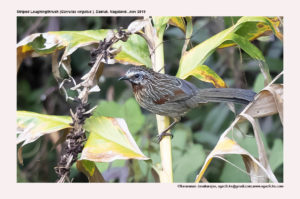
Striped Laughingthrush Garrulax virgatus
Etymology:
- Garrulax : Latin word garrulous –babbling, chattering; ax – inclining towards
- Virgatus : Latin word for striped derived from virga –streak
Vernacular Names: Cachar: Dao-phere
Distribution in India: Pelagic bird found about 30 km from coasts.
Description: Size of 23 cm. It is a fairly small, slim laughingthrush, brown with narrow whitish streaks above, with chestnut wings, buffy-white and rufous face, chestnut throat and whitish-streaked rufous-buff belly. It has a dull chestnut-brown crown and nape, shading to more olive grey-brown on mantle, back and scapulars, all with long whitish shaft streaks. The rump, uppertail-coverts and tail plain are olive grey-brown; greater upperwing-coverts are whitish-tipped rich chestnut, with pale greyish outer primaries and chestnut wing panel. The supercilium from bill base is buffy white, turning white posteriorly, lores are rufous, upper ear-coverts are dull chestnut-brown with buffy streaks. The submoustachial streak, cheek and lower ear-coverts are buffy; chin, malar and upper throat are rich chestnut, shading to rufous-chestnut and acquiring narrow whitish shaft streaks on lower throat and breast. The streaks continue onto pale rufous-buff belly and fading out on more richly rufescent lower underparts. The iris are brown to pale brown or yellowish, orbital skin is dusky plumbeous; bill is black to blackish-brown; legs are flesh to pinkish-grey. Both the sexes are similar. The juvenile is paler, more rufescent above than adult, with paler throat, no streaking on lower underparts..
Habitat: It is found in thick scrub, fern and grass cover near broadleaf evergreen forest, secondary growth, forest edge, and abandoned cultivation. It is found at 900–2400 m.
Food habits: It eats insects. It is found singly or in pairs; not so gregarious as some laughingthrushes. It is mostly skulking..
Breeding habits: They breed in Apr–Jul. The nest is a deep, neat, stoutly built cup, made of tendrils, creeper stems, dead bamboo and other leaves, grasses, roots, fine bents, bracken and moss, lined with fern roots and stalks, moss and grass roots, rootlets, fine grasses and feathery grass-tails, placed from near ground in thick bush, small tree or grass. They lay a clutch of 2–3 eggs.